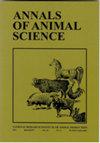Agents of different origins for reduction of mycotoxins’ level in feed
IF 1.9
4区 农林科学
Q1 Veterinary
引用次数: 0
Abstract
Abstract Toxic secondary metabolites of some fungi (mainly representatives of Alternaria, Aspergillus, Fusarium and Penicillium genera) may contaminate agricultural products, representing serious health hazards both to humans and animals. Along with this, the economic losses due to the mycotoxins’ presence in feed production, including crop and animal feedstuff processing and distribution, motivated the plentiful research of detoxification strategies. Feed supplementation with mineral adsorbents (zeolites, hydrated sodium calcium aluminosilicate (HSCAS), bentonites, etc.) is the most prominent approach widely applied. Besides these, other products for mycotoxin level reduction based on the constituents of the yeast cell wall or Lactobacilli are often used. Recently, many investigations are directed toward plant-derived products that can efficiently adsorb mycotoxins in their native (biosorbents) or modified forms (e.g. activated carbon, biochar etc.). These renewable, easily accessible and readily prepared sorbents are economically viable and safe alternatives for mycotoxin decontamination of feed resources. Organic polymers (chitosan, cellulose, etc.) as well as synthetic polymers, such as polyvinyl pyrrolidine, also might reduce mycotoxins’ level in feed. Besides these conventional methods, new research trends are nanotechnologies, the promising, effective, low-cost way for mycotoxins’ removal. This overview systematically summarizes information on binding agents of different origins for the reduction of mycotoxins’ levels in feed. Furthermore, the knowledge of potential applications of binding agents in the feed industry is also reviewed and discussed.采用不同来源的药剂降低饲料中霉菌毒素的含量
摘要某些真菌(主要是霉属、曲霉属、镰刀菌属和青霉属)的有毒次生代谢物可能污染农产品,对人类和动物都有严重的健康危害。与此同时,由于真菌毒素在饲料生产中存在的经济损失,包括作物和动物饲料的加工和分销,促使了对解毒策略的大量研究。饲料中添加矿物吸附剂(沸石、水合铝硅酸钠钙(HSCAS)、膨润土等)是目前应用最为突出的方法。除此之外,还经常使用基于酵母细胞壁或乳酸杆菌成分的其他产品来降低霉菌毒素水平。最近,许多研究都针对能够有效吸附真菌毒素的植物源产品(生物吸附剂)或改性形式(如活性炭、生物炭等)。这些可再生、易于获取和制备的吸附剂是饲料资源真菌毒素净化的经济可行和安全的替代品。有机聚合物(壳聚糖、纤维素等)和合成聚合物(聚乙烯醇吡咯烷等)也可能降低饲料中霉菌毒素的含量。除了这些传统的方法外,新的研究趋势是纳米技术,这是一种有前途的、有效的、低成本的真菌毒素去除方法。本综述系统地总结了用于降低饲料中真菌毒素水平的不同来源的结合剂的信息。此外,还对结合剂在饲料工业中的潜在应用进行了综述和讨论。
本文章由计算机程序翻译,如有差异,请以英文原文为准。
求助全文
约1分钟内获得全文
求助全文
来源期刊

Annals of Animal Science
AGRICULTURE, DAIRY & ANIMAL SCIENCE-
CiteScore
3.80
自引率
5.30%
发文量
138
期刊介绍:
Annals of Animal Science accepts original papers and reviews from the different topics of animal science: genetic and farm animal breeding, the biology, physiology and reproduction of animals, animal nutrition and feedstuffs, environment, hygiene and animal production technology, quality of animal origin products, economics and the organization of animal production.
 求助内容:
求助内容: 应助结果提醒方式:
应助结果提醒方式:


